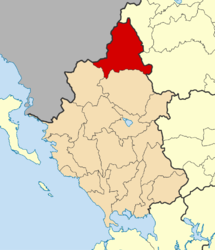Konitsa
|
Konitsa Κόνιτσα |
|
|---|---|

View of Konitsa.
|
|
| Coordinates: 40°3′N 20°45′E / 40.050°N 20.750°ECoordinates: 40°3′N 20°45′E / 40.050°N 20.750°E | |
| Country | Greece |
| Administrative region | Epirus |
| Regional unit | Ioannina |
| Area | |
| • Municipality | 951.2 km2 (367.3 sq mi) |
| • Municipal unit | 542.5 km2 (209.5 sq mi) |
| Elevation | 600 m (2,000 ft) |
| Population (2011) | |
| • Municipality | 6,362 |
| • Municipality density | 6.7/km2 (17/sq mi) |
| • Municipal unit | 4,632 |
| • Municipal unit density | 8.5/km2 (22/sq mi) |
| Community | |
| • Population | 2,942 (2011) |
| • Area (km2) | 54.506 |
| Time zone | EET (UTC+2) |
| • Summer (DST) | EEST (UTC+3) |
| Postal code | 441 00 |
| Area code(s) | 26550 |
| Vehicle registration | ΙΝ |
Konitsa (Greek: Κόνιτσα) is a town of Ioannina in Epirus, Greece, near the Albanian border. It is located north of the capital Ioannina, and northeast of a group of villages known as the Zagorochoria. The town was built amphitheatrically-shaped on a mountain slope of the Pindos mountain range from where it overlooks the valley where the river Aoos meets the river Voidomatis.
Konitsa acts as a regional hub for several small villages of Pindos, and features many shops, schools and a general hospital. Primary aspects of the economy are agriculture and tourism; it is a popular starting point for tourists and hickers who want to explore the Pindos mountains, or who want to go rafting in the river Aoos or parapenting. Due to Konitsa's closeness to places of particular interest, such as the Vikos–Aoös National Park, which includes the Vikos Gorge, the Aoos Gorge and the Tymfi mountains, where the Vikos spring water brand is collected, the Dragonlakes of Tymfi and Smolikas and the sulfur baths of Kavasila, contributed to the increase of tourism in the region.
The town itself is known in Greek as Kónitsa (Κόνιτσα), the villages surrounding it are often known as the Konitsochoria, meaning "the villages of Konitsa". The town is known in Albanian as Konicë, in Aromanian/Vlach as Conița, and in Turkish as Koniçe.
During the Middle Bronze Age (2100-1900 BC) the region of Konitsa was inhabited by Proto-Greek populations. Latter in classical antiquity, the area was part of the territory of the Molossians. At the time of the reign of Pyrrhus of Epirus (297–272 BC) a number of forts existed in strategically important positions.
...
Wikipedia


